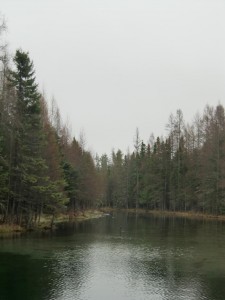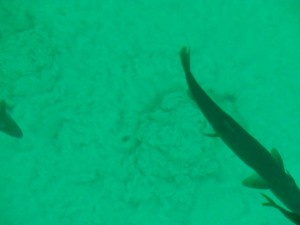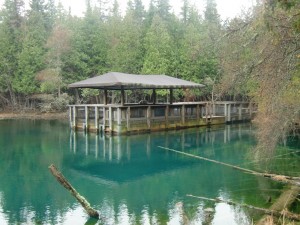TULIP TIME – MICHIGAN’S UPPER PENINSULA
TULIP TIME
This is the seventh in a series of articles about seeing tulips and touring the state of Michigan
MICHIGAN’S UPPER PENINSULA
By Charles N. Stevens
Photos by Dolores Seidman
The cries of seagulls fill the foggy morning in Mackinac City. Geese and ducks walk along the sandy shoreline or bob in the murky water. By the time our bus leaves a light rain is beginning to fall.
Rain intensifies as we as we roll along the highway, our bus enshrouded in fog and mist. Our first adventure of the day is the crossing of the five-mile-long Mackinac Bridge connecting lower Michigan to its Upper Peninsula. Unfortunately, all we can see is mist and limited glances of the gray water of Lake Michigan. Approaching headlights appear ghostly out of the fog as our bus tires sing on the wet metal roadway.
We are now on the Upper Peninsula. The first thing I notice are the many shops selling pasties, a folded meat pie that can be held in the hand. The tradition started during the days when Welshmen worked the mines in the area. Wives prepared them for their husbands who would have a simple but adequate lunch down in the mine.
Conifer forests loom in the fog then fade away, and so do swamps and even sand dunes. It’s surprising to see small patches of snow along the road. We travel along the shore of Lake Michigan, but unfortunately view it through the mist that turns it a murky gray color. We pause at a rest stop on the road so we can get out and walk around. We walk to the shoreline seeing what we can of the hazy lake, and the beaches and rocks. Scrawny trees grow here, adding to the desolate morning.
Back on the bus, we soon arrive at Manistique where the temperature is forty-four degrees. A towering brick chimney materializes out of the fog. Lichen grows on the tree trunks in the soggy town. I know that I’m presenting a bleak picture of the morning, but despite the fog and mist, it is exciting to see new places in all kinds of weather and we are thoroughly enjoying ourselves.
Just outside Manistique is Indian Lake, a deep lake with water so clear that we can see all the way to the bottom. Stepping on to a large raft with a glass bottom, we move by cable out into the lake’s center. We peer down through the glass to the clear, light blue depth of the lake. Here and there water enters the lake, like small artesian wells, at the bottom, pushing up geysers of sand. Large trout swim gracefully through the water, close to the glass, like a fish ballet.
We leave the Hiawatha National Forest and are soon in the town of Rapid River where we stop for lunch. Jack’s Restaurant presented us with a great lunch— grilled cheese sandwiches and nice warm cream of broccoli soup, just right for thawing us out.
Moving on down highway 2, we pass through a timber area of logs, lumber and woodchips. Steam billows from the towering stacks of a paper plant. After passing through Escanaba, we drive by beautiful J.W. Wells State Park with its forests, ponds and beaches. Michigan’s many state parks are all attractive and well-tended .As the fog had dissipated, we now have clear views of blue Lake Michigan, wind-driven whitecaps stirring its surface. Actually what we are seeing is Green Bay, a sub basin of Lake Michigan. Many of the homes in this area have expansive green lawns.
We arrive at the state line at Menominee, Michigan then enter its twin city of Marinette, Wisconsin, now on highway 41. Our bus then rolls through flat land dotted dairy farms. They are all neat and clean with silver silos rising near the white farmhouses. We are told, and we already knew, that Wisconsin was famous for its beer as well as dairy products and cheese.
We enter the town of Green Bay, traveling down Lombardi Avenue (named after the great football coach) that leads to Lambeau Field, home of the famous Green Bay Packers professional football team. The area around the stadium was torn up due to construction. Our motel for the night was the Green Bay Inn, only a stone’s throw from the stadium. Bret Favre, one of the Packer’s most famous quarterbacks, has a restaurant across the street from our motel. But more about that later.

Indian Lake in the Upper Peninsula is so clear, one can see all the way to the bottom.

On the glass-bottomed raft we look down on a fish ballet .

The raft, moved by cables, takes us out to the center of the lake.

At Green Bay, our destination for the day, we pass Lambeau Field, home of the Green Bay Packers football team.
MONTEREY PARK AUTHOR PUBLISHES 4th BOOK – Seeking More of the Sky: Growing Up in the 1930’s:
Charles “Norm” Stevens, a 43 year resident of Monterey Park has recently published his 4th book: Seeking More of the Sky: Growing Up in the 1930’s. This is the story of a young boy growing up in Inglewood, California in the l930’s. This was a time during the depression when unemployment was affecting many and the banks were closed, while the clouds of war were gathering in Europe. But he was lucky enough to be raised in a loving family, the power of that love reflected throughout his stories.
Stevens is the author of three previous books about his experiences during WWII:
An Innocent at Polebrook: A Memoir of an 8th Air Force Bombardier (Story of his 34 bombing missions from his base at Polebrook, England over Germany and France)
The Innocent Cadet: Becoming A World War II Bombardier (A prequel to the first, telling of his training in the U.S. before going overseas into combat.)
Back from Combat: A WWII Bombardier Faces His Military Future from Combat: (This book details the time from when he returned from combat in England until the end of the war.)
He is known to the readers of The Citizen’s Voice as the author of Travel Log Articles including “Cruising the Rhine and Mosel”,” Best of the West”, “In Search of Snow” , “From Paris to Normandy on the Seine”, and “Exploring New York”. He is retired, having taught for 32 years, primarily in the Montebello Unified School District.
Those interested in purchasing an autographed copy of any of his books, may contact the author at 323-721-8230 or Normstevens24@gmail.com.



